Strategic Management Report: Evaluation of Porter's Generic Strategies
VerifiedAdded on 2023/04/11
|19
|3919
|283
Report
AI Summary
This report provides a comprehensive analysis of Porter's Generic Strategies within the context of strategic management. It begins with an executive summary and introduction, outlining the core concepts and objectives. The report defines and overviews Porter’s Generic Strategies, including cost leadership, differentiation, and focus strategies, supported by relevant figures and diagrams. It explores the historical context of these strategies, discussing their evolution and the arguments surrounding their creation. The report then examines the application of these strategies in the present business scenario, providing real-world examples of organizations that employ cost leadership (Walmart), differentiation (McDonald's), and focus strategies (PepsiCo). It also addresses the relevancy of Porter’s Generic Forces in handling business challenges. The report concludes by summarizing the key findings and offering recommendations to improve the overall strategic management approach. References are provided to support the analysis.
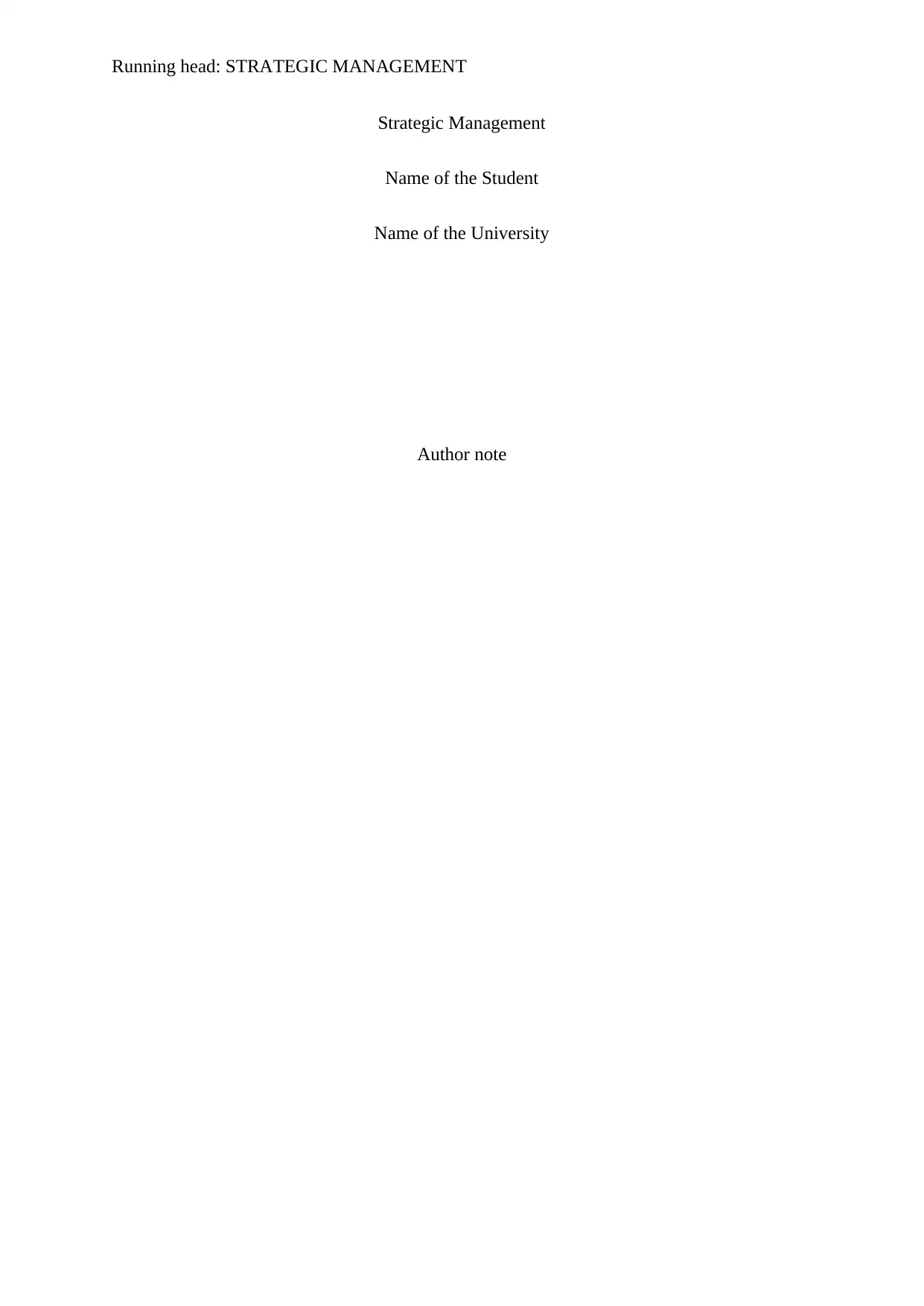
Running head: STRATEGIC MANAGEMENT
Strategic Management
Name of the Student
Name of the University
Author note
Strategic Management
Name of the Student
Name of the University
Author note
Paraphrase This Document
Need a fresh take? Get an instant paraphrase of this document with our AI Paraphraser
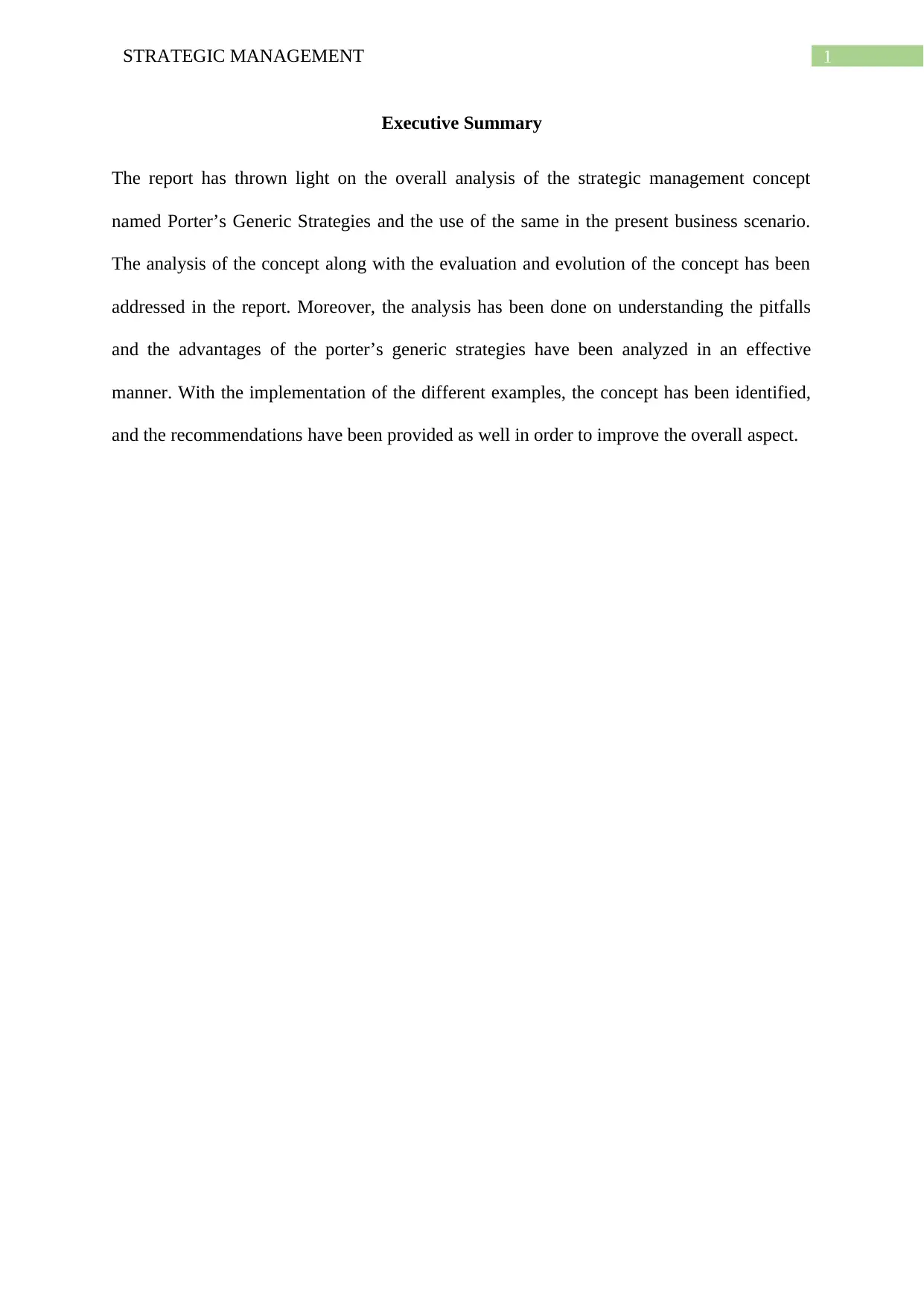
1STRATEGIC MANAGEMENT
Executive Summary
The report has thrown light on the overall analysis of the strategic management concept
named Porter’s Generic Strategies and the use of the same in the present business scenario.
The analysis of the concept along with the evaluation and evolution of the concept has been
addressed in the report. Moreover, the analysis has been done on understanding the pitfalls
and the advantages of the porter’s generic strategies have been analyzed in an effective
manner. With the implementation of the different examples, the concept has been identified,
and the recommendations have been provided as well in order to improve the overall aspect.
Executive Summary
The report has thrown light on the overall analysis of the strategic management concept
named Porter’s Generic Strategies and the use of the same in the present business scenario.
The analysis of the concept along with the evaluation and evolution of the concept has been
addressed in the report. Moreover, the analysis has been done on understanding the pitfalls
and the advantages of the porter’s generic strategies have been analyzed in an effective
manner. With the implementation of the different examples, the concept has been identified,
and the recommendations have been provided as well in order to improve the overall aspect.
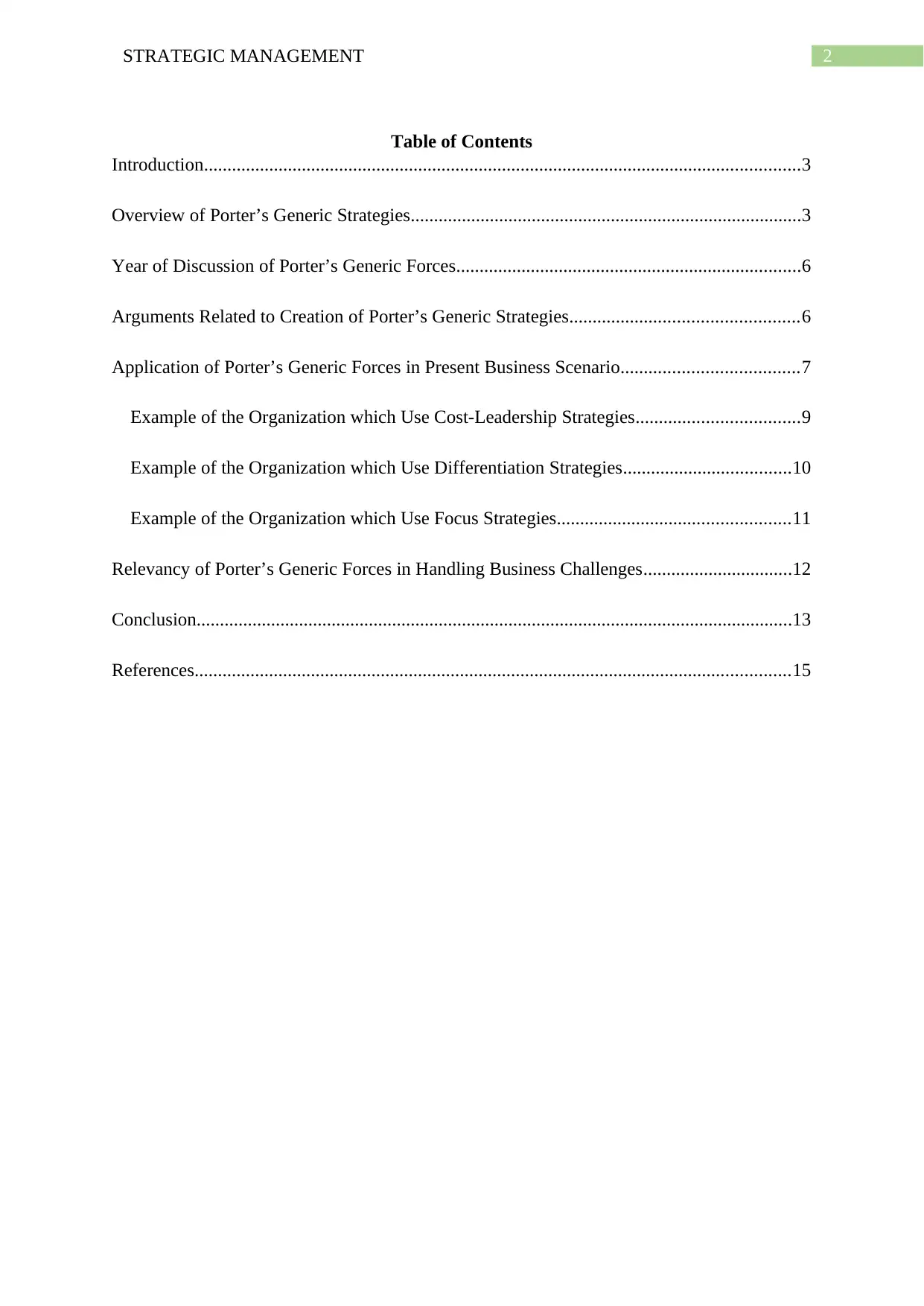
2STRATEGIC MANAGEMENT
Table of Contents
Introduction................................................................................................................................3
Overview of Porter’s Generic Strategies....................................................................................3
Year of Discussion of Porter’s Generic Forces..........................................................................6
Arguments Related to Creation of Porter’s Generic Strategies.................................................6
Application of Porter’s Generic Forces in Present Business Scenario......................................7
Example of the Organization which Use Cost-Leadership Strategies...................................9
Example of the Organization which Use Differentiation Strategies....................................10
Example of the Organization which Use Focus Strategies..................................................11
Relevancy of Porter’s Generic Forces in Handling Business Challenges................................12
Conclusion................................................................................................................................13
References................................................................................................................................15
Table of Contents
Introduction................................................................................................................................3
Overview of Porter’s Generic Strategies....................................................................................3
Year of Discussion of Porter’s Generic Forces..........................................................................6
Arguments Related to Creation of Porter’s Generic Strategies.................................................6
Application of Porter’s Generic Forces in Present Business Scenario......................................7
Example of the Organization which Use Cost-Leadership Strategies...................................9
Example of the Organization which Use Differentiation Strategies....................................10
Example of the Organization which Use Focus Strategies..................................................11
Relevancy of Porter’s Generic Forces in Handling Business Challenges................................12
Conclusion................................................................................................................................13
References................................................................................................................................15
⊘ This is a preview!⊘
Do you want full access?
Subscribe today to unlock all pages.

Trusted by 1+ million students worldwide
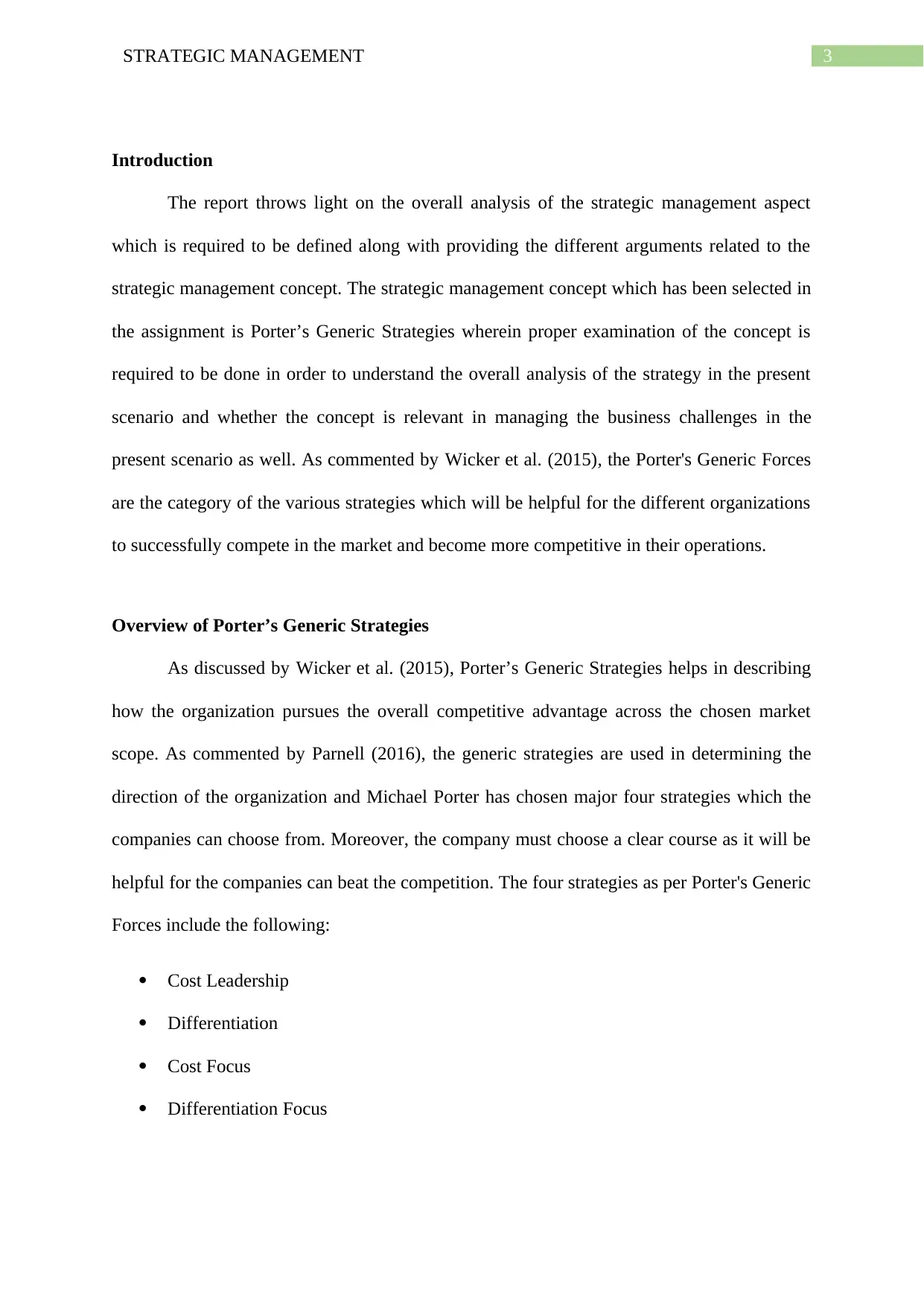
3STRATEGIC MANAGEMENT
Introduction
The report throws light on the overall analysis of the strategic management aspect
which is required to be defined along with providing the different arguments related to the
strategic management concept. The strategic management concept which has been selected in
the assignment is Porter’s Generic Strategies wherein proper examination of the concept is
required to be done in order to understand the overall analysis of the strategy in the present
scenario and whether the concept is relevant in managing the business challenges in the
present scenario as well. As commented by Wicker et al. (2015), the Porter's Generic Forces
are the category of the various strategies which will be helpful for the different organizations
to successfully compete in the market and become more competitive in their operations.
Overview of Porter’s Generic Strategies
As discussed by Wicker et al. (2015), Porter’s Generic Strategies helps in describing
how the organization pursues the overall competitive advantage across the chosen market
scope. As commented by Parnell (2016), the generic strategies are used in determining the
direction of the organization and Michael Porter has chosen major four strategies which the
companies can choose from. Moreover, the company must choose a clear course as it will be
helpful for the companies can beat the competition. The four strategies as per Porter's Generic
Forces include the following:
Cost Leadership
Differentiation
Cost Focus
Differentiation Focus
Introduction
The report throws light on the overall analysis of the strategic management aspect
which is required to be defined along with providing the different arguments related to the
strategic management concept. The strategic management concept which has been selected in
the assignment is Porter’s Generic Strategies wherein proper examination of the concept is
required to be done in order to understand the overall analysis of the strategy in the present
scenario and whether the concept is relevant in managing the business challenges in the
present scenario as well. As commented by Wicker et al. (2015), the Porter's Generic Forces
are the category of the various strategies which will be helpful for the different organizations
to successfully compete in the market and become more competitive in their operations.
Overview of Porter’s Generic Strategies
As discussed by Wicker et al. (2015), Porter’s Generic Strategies helps in describing
how the organization pursues the overall competitive advantage across the chosen market
scope. As commented by Parnell (2016), the generic strategies are used in determining the
direction of the organization and Michael Porter has chosen major four strategies which the
companies can choose from. Moreover, the company must choose a clear course as it will be
helpful for the companies can beat the competition. The four strategies as per Porter's Generic
Forces include the following:
Cost Leadership
Differentiation
Cost Focus
Differentiation Focus
Paraphrase This Document
Need a fresh take? Get an instant paraphrase of this document with our AI Paraphraser
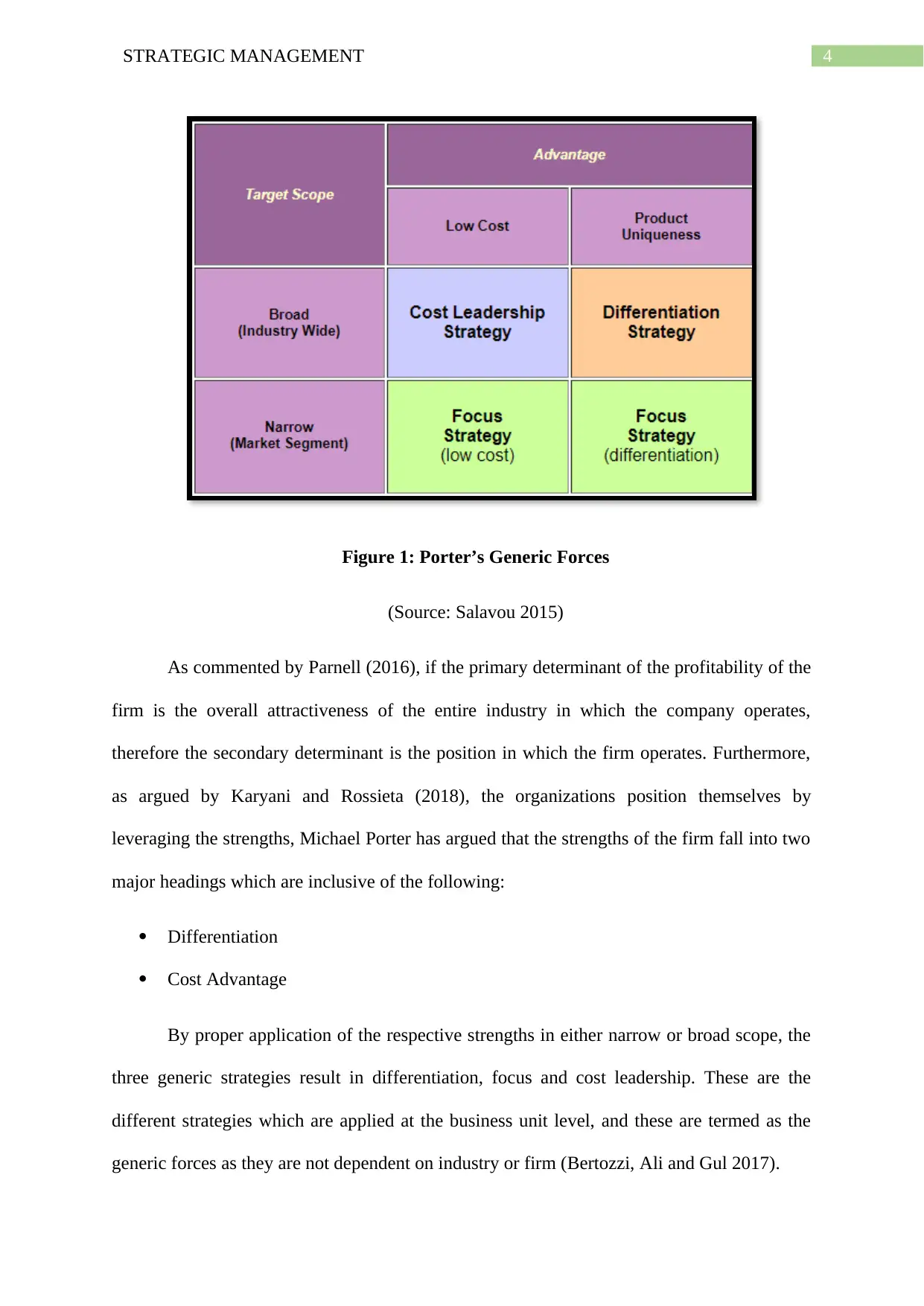
4STRATEGIC MANAGEMENT
Figure 1: Porter’s Generic Forces
(Source: Salavou 2015)
As commented by Parnell (2016), if the primary determinant of the profitability of the
firm is the overall attractiveness of the entire industry in which the company operates,
therefore the secondary determinant is the position in which the firm operates. Furthermore,
as argued by Karyani and Rossieta (2018), the organizations position themselves by
leveraging the strengths, Michael Porter has argued that the strengths of the firm fall into two
major headings which are inclusive of the following:
Differentiation
Cost Advantage
By proper application of the respective strengths in either narrow or broad scope, the
three generic strategies result in differentiation, focus and cost leadership. These are the
different strategies which are applied at the business unit level, and these are termed as the
generic forces as they are not dependent on industry or firm (Bertozzi, Ali and Gul 2017).
Figure 1: Porter’s Generic Forces
(Source: Salavou 2015)
As commented by Parnell (2016), if the primary determinant of the profitability of the
firm is the overall attractiveness of the entire industry in which the company operates,
therefore the secondary determinant is the position in which the firm operates. Furthermore,
as argued by Karyani and Rossieta (2018), the organizations position themselves by
leveraging the strengths, Michael Porter has argued that the strengths of the firm fall into two
major headings which are inclusive of the following:
Differentiation
Cost Advantage
By proper application of the respective strengths in either narrow or broad scope, the
three generic strategies result in differentiation, focus and cost leadership. These are the
different strategies which are applied at the business unit level, and these are termed as the
generic forces as they are not dependent on industry or firm (Bertozzi, Ali and Gul 2017).
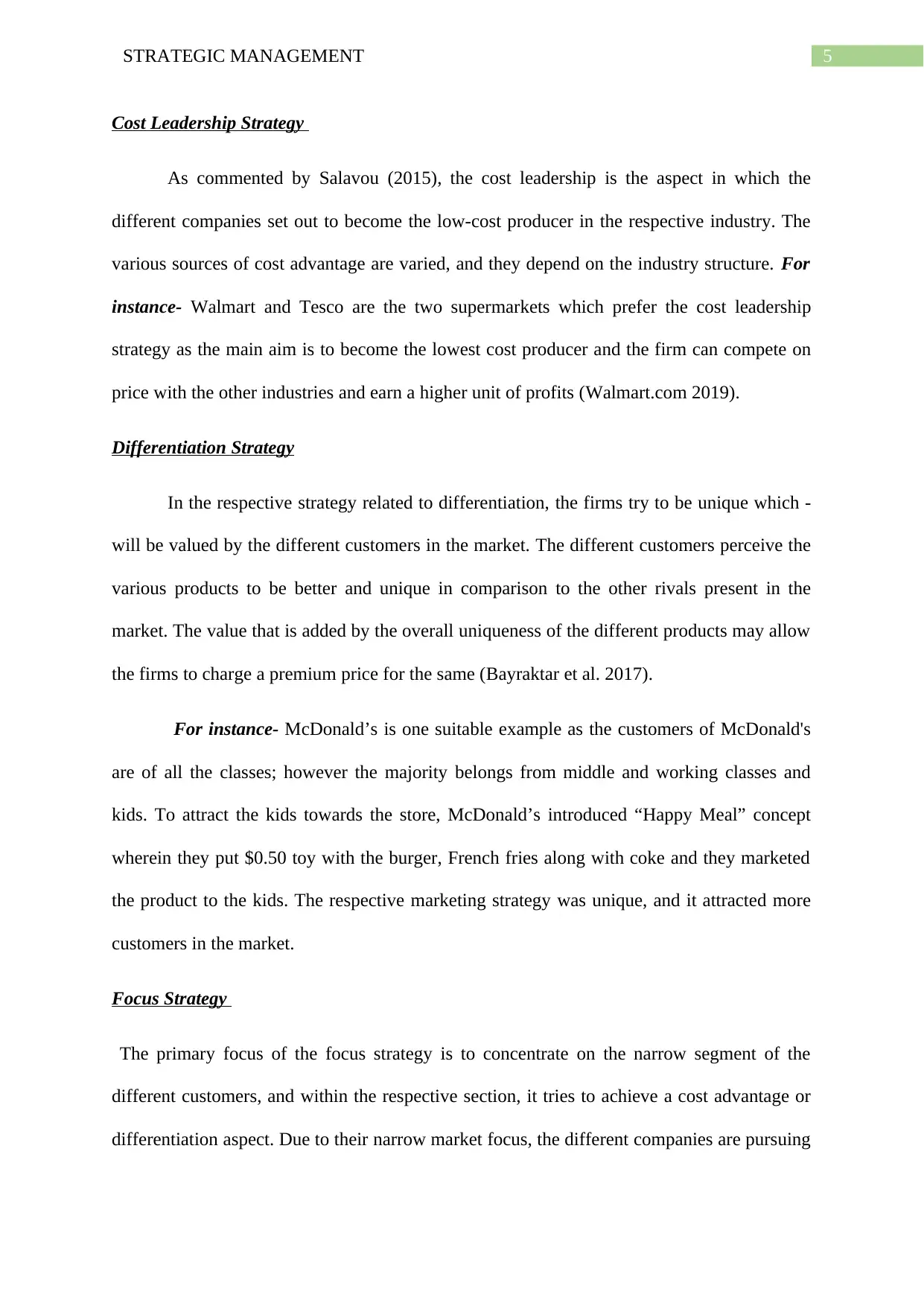
5STRATEGIC MANAGEMENT
Cost Leadership Strategy
As commented by Salavou (2015), the cost leadership is the aspect in which the
different companies set out to become the low-cost producer in the respective industry. The
various sources of cost advantage are varied, and they depend on the industry structure. For
instance- Walmart and Tesco are the two supermarkets which prefer the cost leadership
strategy as the main aim is to become the lowest cost producer and the firm can compete on
price with the other industries and earn a higher unit of profits (Walmart.com 2019).
Differentiation Strategy
In the respective strategy related to differentiation, the firms try to be unique which -
will be valued by the different customers in the market. The different customers perceive the
various products to be better and unique in comparison to the other rivals present in the
market. The value that is added by the overall uniqueness of the different products may allow
the firms to charge a premium price for the same (Bayraktar et al. 2017).
For instance- McDonald’s is one suitable example as the customers of McDonald's
are of all the classes; however the majority belongs from middle and working classes and
kids. To attract the kids towards the store, McDonald’s introduced “Happy Meal” concept
wherein they put $0.50 toy with the burger, French fries along with coke and they marketed
the product to the kids. The respective marketing strategy was unique, and it attracted more
customers in the market.
Focus Strategy
The primary focus of the focus strategy is to concentrate on the narrow segment of the
different customers, and within the respective section, it tries to achieve a cost advantage or
differentiation aspect. Due to their narrow market focus, the different companies are pursuing
Cost Leadership Strategy
As commented by Salavou (2015), the cost leadership is the aspect in which the
different companies set out to become the low-cost producer in the respective industry. The
various sources of cost advantage are varied, and they depend on the industry structure. For
instance- Walmart and Tesco are the two supermarkets which prefer the cost leadership
strategy as the main aim is to become the lowest cost producer and the firm can compete on
price with the other industries and earn a higher unit of profits (Walmart.com 2019).
Differentiation Strategy
In the respective strategy related to differentiation, the firms try to be unique which -
will be valued by the different customers in the market. The different customers perceive the
various products to be better and unique in comparison to the other rivals present in the
market. The value that is added by the overall uniqueness of the different products may allow
the firms to charge a premium price for the same (Bayraktar et al. 2017).
For instance- McDonald’s is one suitable example as the customers of McDonald's
are of all the classes; however the majority belongs from middle and working classes and
kids. To attract the kids towards the store, McDonald’s introduced “Happy Meal” concept
wherein they put $0.50 toy with the burger, French fries along with coke and they marketed
the product to the kids. The respective marketing strategy was unique, and it attracted more
customers in the market.
Focus Strategy
The primary focus of the focus strategy is to concentrate on the narrow segment of the
different customers, and within the respective section, it tries to achieve a cost advantage or
differentiation aspect. Due to their narrow market focus, the different companies are pursuing
⊘ This is a preview!⊘
Do you want full access?
Subscribe today to unlock all pages.

Trusted by 1+ million students worldwide
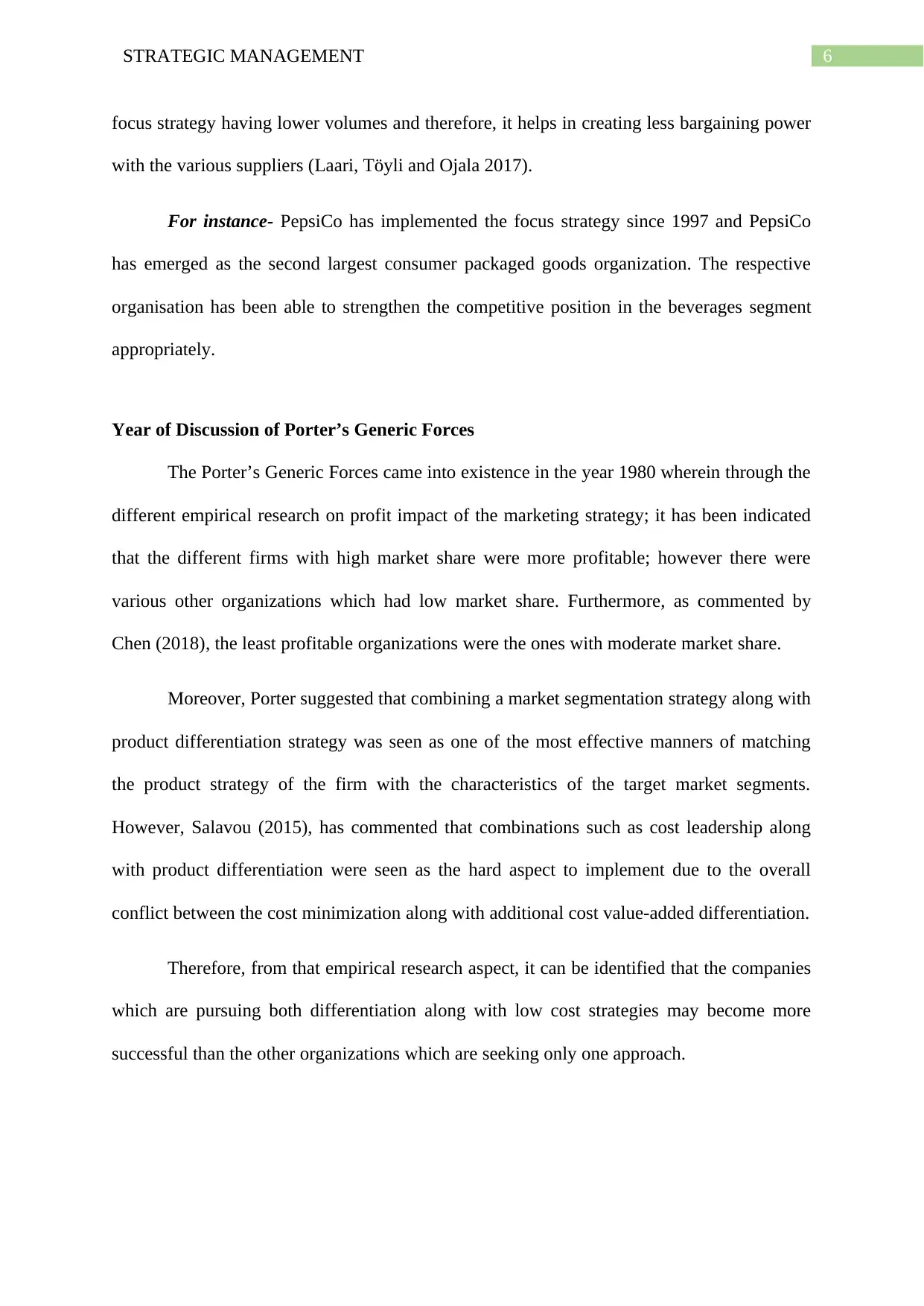
6STRATEGIC MANAGEMENT
focus strategy having lower volumes and therefore, it helps in creating less bargaining power
with the various suppliers (Laari, Töyli and Ojala 2017).
For instance- PepsiCo has implemented the focus strategy since 1997 and PepsiCo
has emerged as the second largest consumer packaged goods organization. The respective
organisation has been able to strengthen the competitive position in the beverages segment
appropriately.
Year of Discussion of Porter’s Generic Forces
The Porter’s Generic Forces came into existence in the year 1980 wherein through the
different empirical research on profit impact of the marketing strategy; it has been indicated
that the different firms with high market share were more profitable; however there were
various other organizations which had low market share. Furthermore, as commented by
Chen (2018), the least profitable organizations were the ones with moderate market share.
Moreover, Porter suggested that combining a market segmentation strategy along with
product differentiation strategy was seen as one of the most effective manners of matching
the product strategy of the firm with the characteristics of the target market segments.
However, Salavou (2015), has commented that combinations such as cost leadership along
with product differentiation were seen as the hard aspect to implement due to the overall
conflict between the cost minimization along with additional cost value-added differentiation.
Therefore, from that empirical research aspect, it can be identified that the companies
which are pursuing both differentiation along with low cost strategies may become more
successful than the other organizations which are seeking only one approach.
focus strategy having lower volumes and therefore, it helps in creating less bargaining power
with the various suppliers (Laari, Töyli and Ojala 2017).
For instance- PepsiCo has implemented the focus strategy since 1997 and PepsiCo
has emerged as the second largest consumer packaged goods organization. The respective
organisation has been able to strengthen the competitive position in the beverages segment
appropriately.
Year of Discussion of Porter’s Generic Forces
The Porter’s Generic Forces came into existence in the year 1980 wherein through the
different empirical research on profit impact of the marketing strategy; it has been indicated
that the different firms with high market share were more profitable; however there were
various other organizations which had low market share. Furthermore, as commented by
Chen (2018), the least profitable organizations were the ones with moderate market share.
Moreover, Porter suggested that combining a market segmentation strategy along with
product differentiation strategy was seen as one of the most effective manners of matching
the product strategy of the firm with the characteristics of the target market segments.
However, Salavou (2015), has commented that combinations such as cost leadership along
with product differentiation were seen as the hard aspect to implement due to the overall
conflict between the cost minimization along with additional cost value-added differentiation.
Therefore, from that empirical research aspect, it can be identified that the companies
which are pursuing both differentiation along with low cost strategies may become more
successful than the other organizations which are seeking only one approach.
Paraphrase This Document
Need a fresh take? Get an instant paraphrase of this document with our AI Paraphraser
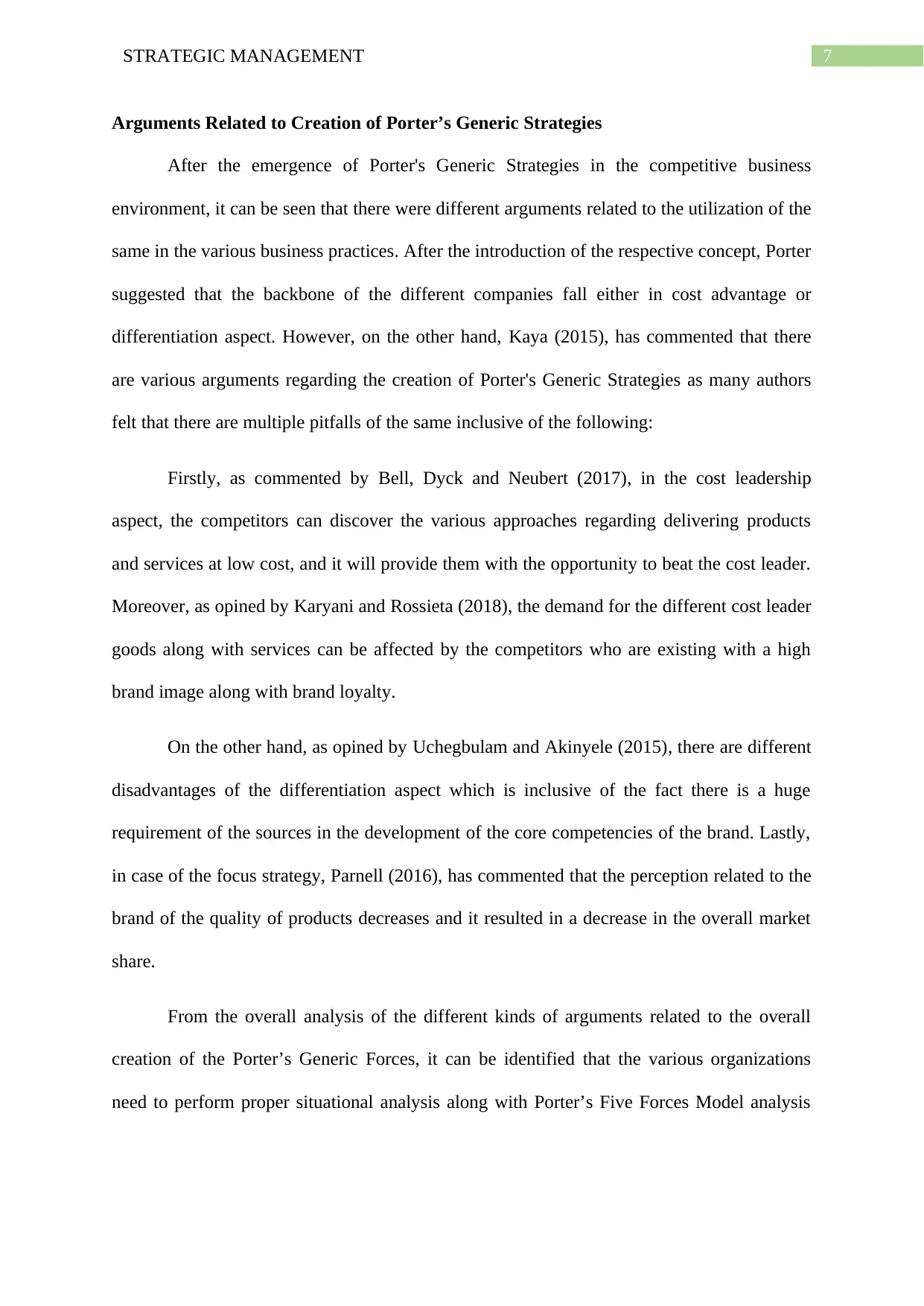
7STRATEGIC MANAGEMENT
Arguments Related to Creation of Porter’s Generic Strategies
After the emergence of Porter's Generic Strategies in the competitive business
environment, it can be seen that there were different arguments related to the utilization of the
same in the various business practices. After the introduction of the respective concept, Porter
suggested that the backbone of the different companies fall either in cost advantage or
differentiation aspect. However, on the other hand, Kaya (2015), has commented that there
are various arguments regarding the creation of Porter's Generic Strategies as many authors
felt that there are multiple pitfalls of the same inclusive of the following:
Firstly, as commented by Bell, Dyck and Neubert (2017), in the cost leadership
aspect, the competitors can discover the various approaches regarding delivering products
and services at low cost, and it will provide them with the opportunity to beat the cost leader.
Moreover, as opined by Karyani and Rossieta (2018), the demand for the different cost leader
goods along with services can be affected by the competitors who are existing with a high
brand image along with brand loyalty.
On the other hand, as opined by Uchegbulam and Akinyele (2015), there are different
disadvantages of the differentiation aspect which is inclusive of the fact there is a huge
requirement of the sources in the development of the core competencies of the brand. Lastly,
in case of the focus strategy, Parnell (2016), has commented that the perception related to the
brand of the quality of products decreases and it resulted in a decrease in the overall market
share.
From the overall analysis of the different kinds of arguments related to the overall
creation of the Porter’s Generic Forces, it can be identified that the various organizations
need to perform proper situational analysis along with Porter’s Five Forces Model analysis
Arguments Related to Creation of Porter’s Generic Strategies
After the emergence of Porter's Generic Strategies in the competitive business
environment, it can be seen that there were different arguments related to the utilization of the
same in the various business practices. After the introduction of the respective concept, Porter
suggested that the backbone of the different companies fall either in cost advantage or
differentiation aspect. However, on the other hand, Kaya (2015), has commented that there
are various arguments regarding the creation of Porter's Generic Strategies as many authors
felt that there are multiple pitfalls of the same inclusive of the following:
Firstly, as commented by Bell, Dyck and Neubert (2017), in the cost leadership
aspect, the competitors can discover the various approaches regarding delivering products
and services at low cost, and it will provide them with the opportunity to beat the cost leader.
Moreover, as opined by Karyani and Rossieta (2018), the demand for the different cost leader
goods along with services can be affected by the competitors who are existing with a high
brand image along with brand loyalty.
On the other hand, as opined by Uchegbulam and Akinyele (2015), there are different
disadvantages of the differentiation aspect which is inclusive of the fact there is a huge
requirement of the sources in the development of the core competencies of the brand. Lastly,
in case of the focus strategy, Parnell (2016), has commented that the perception related to the
brand of the quality of products decreases and it resulted in a decrease in the overall market
share.
From the overall analysis of the different kinds of arguments related to the overall
creation of the Porter’s Generic Forces, it can be identified that the various organizations
need to perform proper situational analysis along with Porter’s Five Forces Model analysis
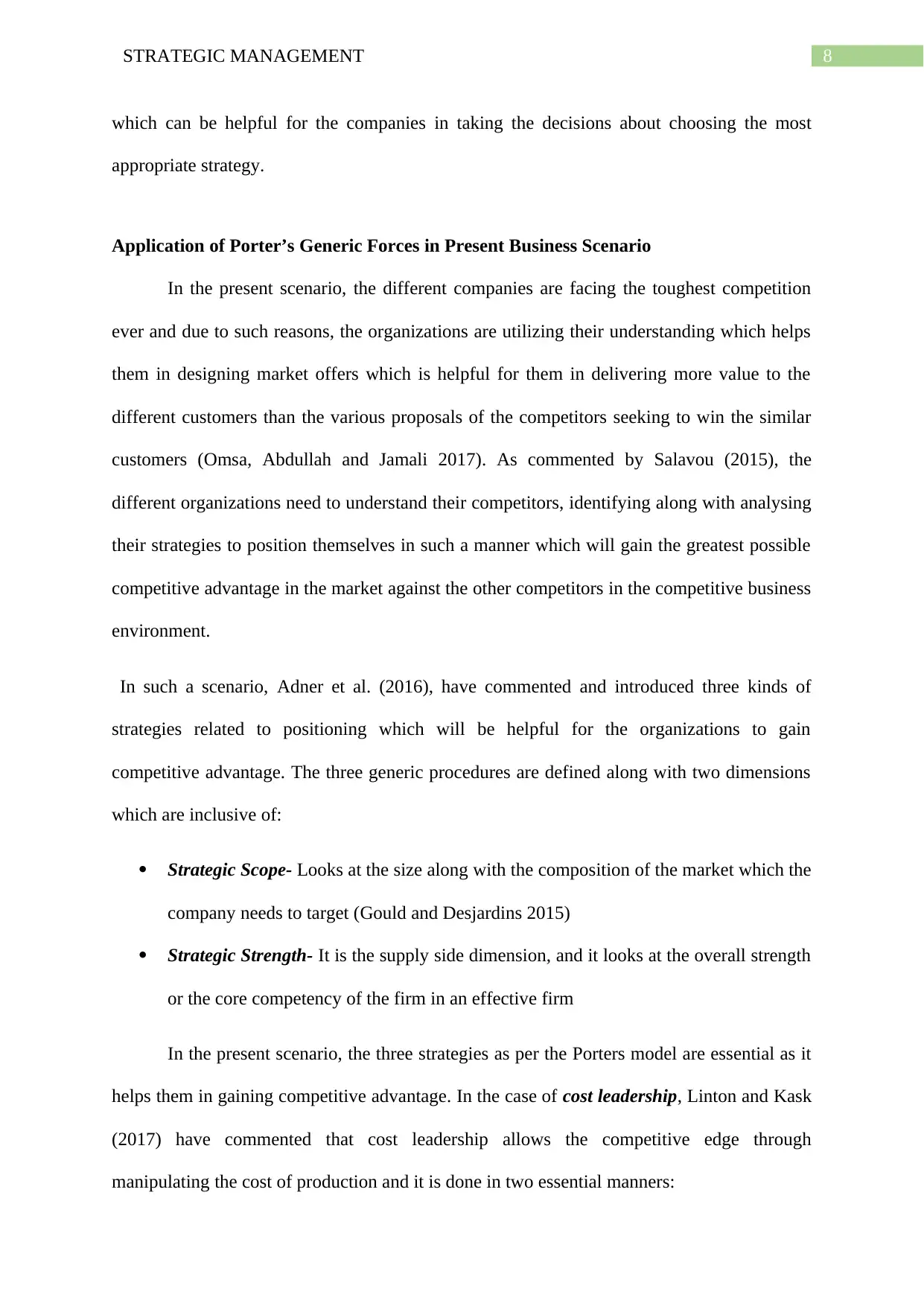
8STRATEGIC MANAGEMENT
which can be helpful for the companies in taking the decisions about choosing the most
appropriate strategy.
Application of Porter’s Generic Forces in Present Business Scenario
In the present scenario, the different companies are facing the toughest competition
ever and due to such reasons, the organizations are utilizing their understanding which helps
them in designing market offers which is helpful for them in delivering more value to the
different customers than the various proposals of the competitors seeking to win the similar
customers (Omsa, Abdullah and Jamali 2017). As commented by Salavou (2015), the
different organizations need to understand their competitors, identifying along with analysing
their strategies to position themselves in such a manner which will gain the greatest possible
competitive advantage in the market against the other competitors in the competitive business
environment.
In such a scenario, Adner et al. (2016), have commented and introduced three kinds of
strategies related to positioning which will be helpful for the organizations to gain
competitive advantage. The three generic procedures are defined along with two dimensions
which are inclusive of:
Strategic Scope- Looks at the size along with the composition of the market which the
company needs to target (Gould and Desjardins 2015)
Strategic Strength- It is the supply side dimension, and it looks at the overall strength
or the core competency of the firm in an effective firm
In the present scenario, the three strategies as per the Porters model are essential as it
helps them in gaining competitive advantage. In the case of cost leadership, Linton and Kask
(2017) have commented that cost leadership allows the competitive edge through
manipulating the cost of production and it is done in two essential manners:
which can be helpful for the companies in taking the decisions about choosing the most
appropriate strategy.
Application of Porter’s Generic Forces in Present Business Scenario
In the present scenario, the different companies are facing the toughest competition
ever and due to such reasons, the organizations are utilizing their understanding which helps
them in designing market offers which is helpful for them in delivering more value to the
different customers than the various proposals of the competitors seeking to win the similar
customers (Omsa, Abdullah and Jamali 2017). As commented by Salavou (2015), the
different organizations need to understand their competitors, identifying along with analysing
their strategies to position themselves in such a manner which will gain the greatest possible
competitive advantage in the market against the other competitors in the competitive business
environment.
In such a scenario, Adner et al. (2016), have commented and introduced three kinds of
strategies related to positioning which will be helpful for the organizations to gain
competitive advantage. The three generic procedures are defined along with two dimensions
which are inclusive of:
Strategic Scope- Looks at the size along with the composition of the market which the
company needs to target (Gould and Desjardins 2015)
Strategic Strength- It is the supply side dimension, and it looks at the overall strength
or the core competency of the firm in an effective firm
In the present scenario, the three strategies as per the Porters model are essential as it
helps them in gaining competitive advantage. In the case of cost leadership, Linton and Kask
(2017) have commented that cost leadership allows the competitive edge through
manipulating the cost of production and it is done in two essential manners:
⊘ This is a preview!⊘
Do you want full access?
Subscribe today to unlock all pages.

Trusted by 1+ million students worldwide
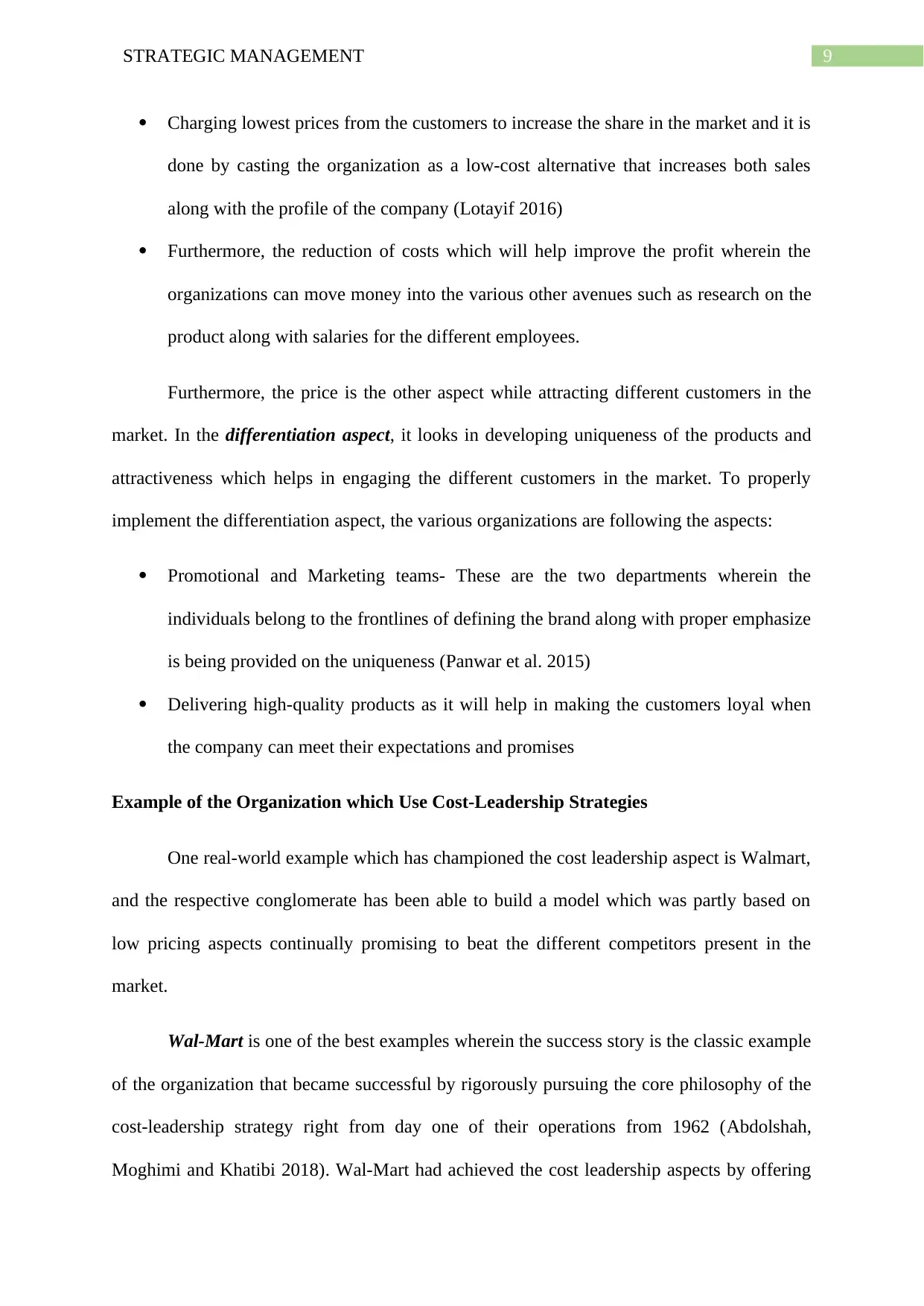
9STRATEGIC MANAGEMENT
Charging lowest prices from the customers to increase the share in the market and it is
done by casting the organization as a low-cost alternative that increases both sales
along with the profile of the company (Lotayif 2016)
Furthermore, the reduction of costs which will help improve the profit wherein the
organizations can move money into the various other avenues such as research on the
product along with salaries for the different employees.
Furthermore, the price is the other aspect while attracting different customers in the
market. In the differentiation aspect, it looks in developing uniqueness of the products and
attractiveness which helps in engaging the different customers in the market. To properly
implement the differentiation aspect, the various organizations are following the aspects:
Promotional and Marketing teams- These are the two departments wherein the
individuals belong to the frontlines of defining the brand along with proper emphasize
is being provided on the uniqueness (Panwar et al. 2015)
Delivering high-quality products as it will help in making the customers loyal when
the company can meet their expectations and promises
Example of the Organization which Use Cost-Leadership Strategies
One real-world example which has championed the cost leadership aspect is Walmart,
and the respective conglomerate has been able to build a model which was partly based on
low pricing aspects continually promising to beat the different competitors present in the
market.
Wal-Mart is one of the best examples wherein the success story is the classic example
of the organization that became successful by rigorously pursuing the core philosophy of the
cost-leadership strategy right from day one of their operations from 1962 (Abdolshah,
Moghimi and Khatibi 2018). Wal-Mart had achieved the cost leadership aspects by offering
Charging lowest prices from the customers to increase the share in the market and it is
done by casting the organization as a low-cost alternative that increases both sales
along with the profile of the company (Lotayif 2016)
Furthermore, the reduction of costs which will help improve the profit wherein the
organizations can move money into the various other avenues such as research on the
product along with salaries for the different employees.
Furthermore, the price is the other aspect while attracting different customers in the
market. In the differentiation aspect, it looks in developing uniqueness of the products and
attractiveness which helps in engaging the different customers in the market. To properly
implement the differentiation aspect, the various organizations are following the aspects:
Promotional and Marketing teams- These are the two departments wherein the
individuals belong to the frontlines of defining the brand along with proper emphasize
is being provided on the uniqueness (Panwar et al. 2015)
Delivering high-quality products as it will help in making the customers loyal when
the company can meet their expectations and promises
Example of the Organization which Use Cost-Leadership Strategies
One real-world example which has championed the cost leadership aspect is Walmart,
and the respective conglomerate has been able to build a model which was partly based on
low pricing aspects continually promising to beat the different competitors present in the
market.
Wal-Mart is one of the best examples wherein the success story is the classic example
of the organization that became successful by rigorously pursuing the core philosophy of the
cost-leadership strategy right from day one of their operations from 1962 (Abdolshah,
Moghimi and Khatibi 2018). Wal-Mart had achieved the cost leadership aspects by offering
Paraphrase This Document
Need a fresh take? Get an instant paraphrase of this document with our AI Paraphraser
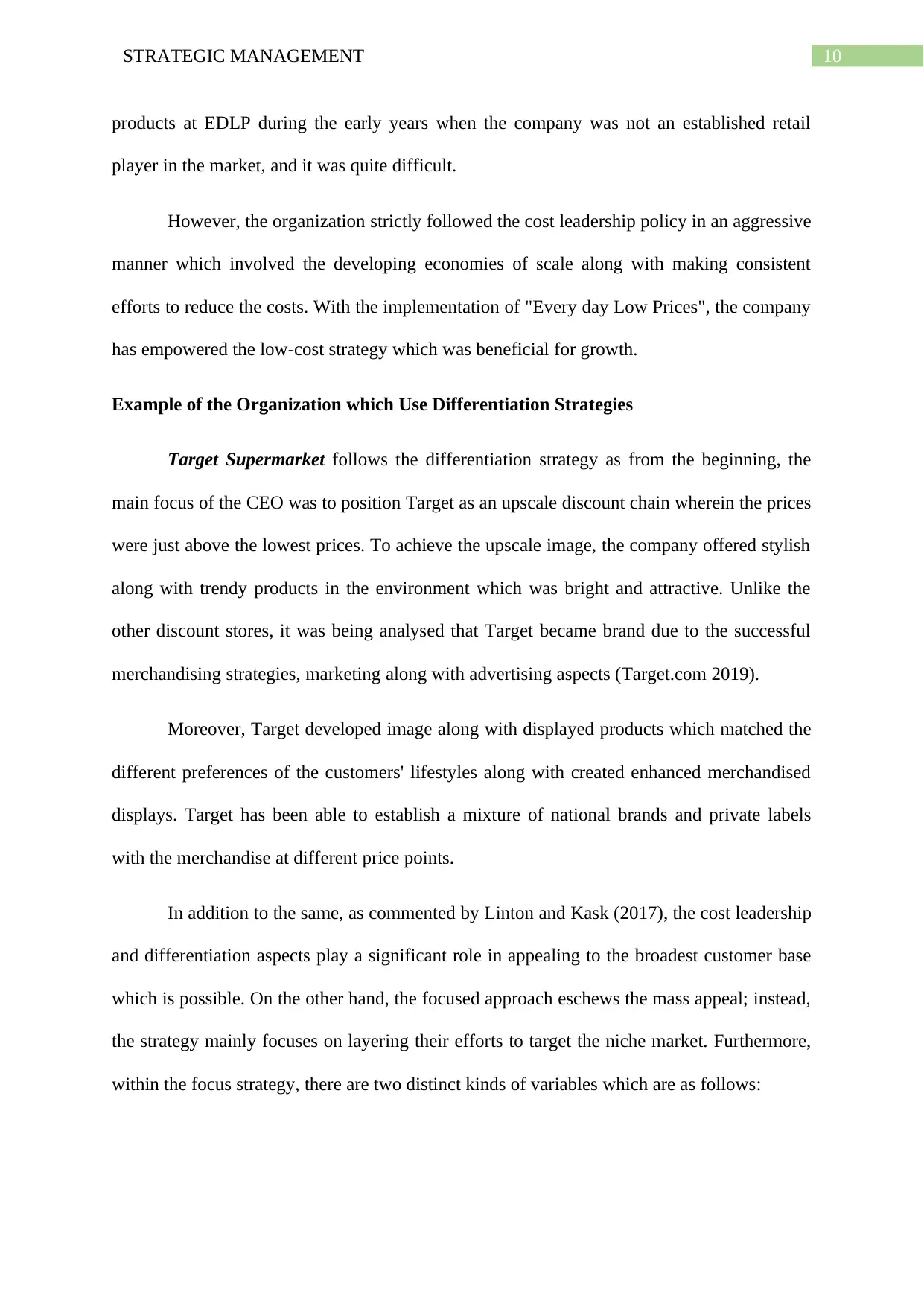
10STRATEGIC MANAGEMENT
products at EDLP during the early years when the company was not an established retail
player in the market, and it was quite difficult.
However, the organization strictly followed the cost leadership policy in an aggressive
manner which involved the developing economies of scale along with making consistent
efforts to reduce the costs. With the implementation of "Every day Low Prices", the company
has empowered the low-cost strategy which was beneficial for growth.
Example of the Organization which Use Differentiation Strategies
Target Supermarket follows the differentiation strategy as from the beginning, the
main focus of the CEO was to position Target as an upscale discount chain wherein the prices
were just above the lowest prices. To achieve the upscale image, the company offered stylish
along with trendy products in the environment which was bright and attractive. Unlike the
other discount stores, it was being analysed that Target became brand due to the successful
merchandising strategies, marketing along with advertising aspects (Target.com 2019).
Moreover, Target developed image along with displayed products which matched the
different preferences of the customers' lifestyles along with created enhanced merchandised
displays. Target has been able to establish a mixture of national brands and private labels
with the merchandise at different price points.
In addition to the same, as commented by Linton and Kask (2017), the cost leadership
and differentiation aspects play a significant role in appealing to the broadest customer base
which is possible. On the other hand, the focused approach eschews the mass appeal; instead,
the strategy mainly focuses on layering their efforts to target the niche market. Furthermore,
within the focus strategy, there are two distinct kinds of variables which are as follows:
products at EDLP during the early years when the company was not an established retail
player in the market, and it was quite difficult.
However, the organization strictly followed the cost leadership policy in an aggressive
manner which involved the developing economies of scale along with making consistent
efforts to reduce the costs. With the implementation of "Every day Low Prices", the company
has empowered the low-cost strategy which was beneficial for growth.
Example of the Organization which Use Differentiation Strategies
Target Supermarket follows the differentiation strategy as from the beginning, the
main focus of the CEO was to position Target as an upscale discount chain wherein the prices
were just above the lowest prices. To achieve the upscale image, the company offered stylish
along with trendy products in the environment which was bright and attractive. Unlike the
other discount stores, it was being analysed that Target became brand due to the successful
merchandising strategies, marketing along with advertising aspects (Target.com 2019).
Moreover, Target developed image along with displayed products which matched the
different preferences of the customers' lifestyles along with created enhanced merchandised
displays. Target has been able to establish a mixture of national brands and private labels
with the merchandise at different price points.
In addition to the same, as commented by Linton and Kask (2017), the cost leadership
and differentiation aspects play a significant role in appealing to the broadest customer base
which is possible. On the other hand, the focused approach eschews the mass appeal; instead,
the strategy mainly focuses on layering their efforts to target the niche market. Furthermore,
within the focus strategy, there are two distinct kinds of variables which are as follows:
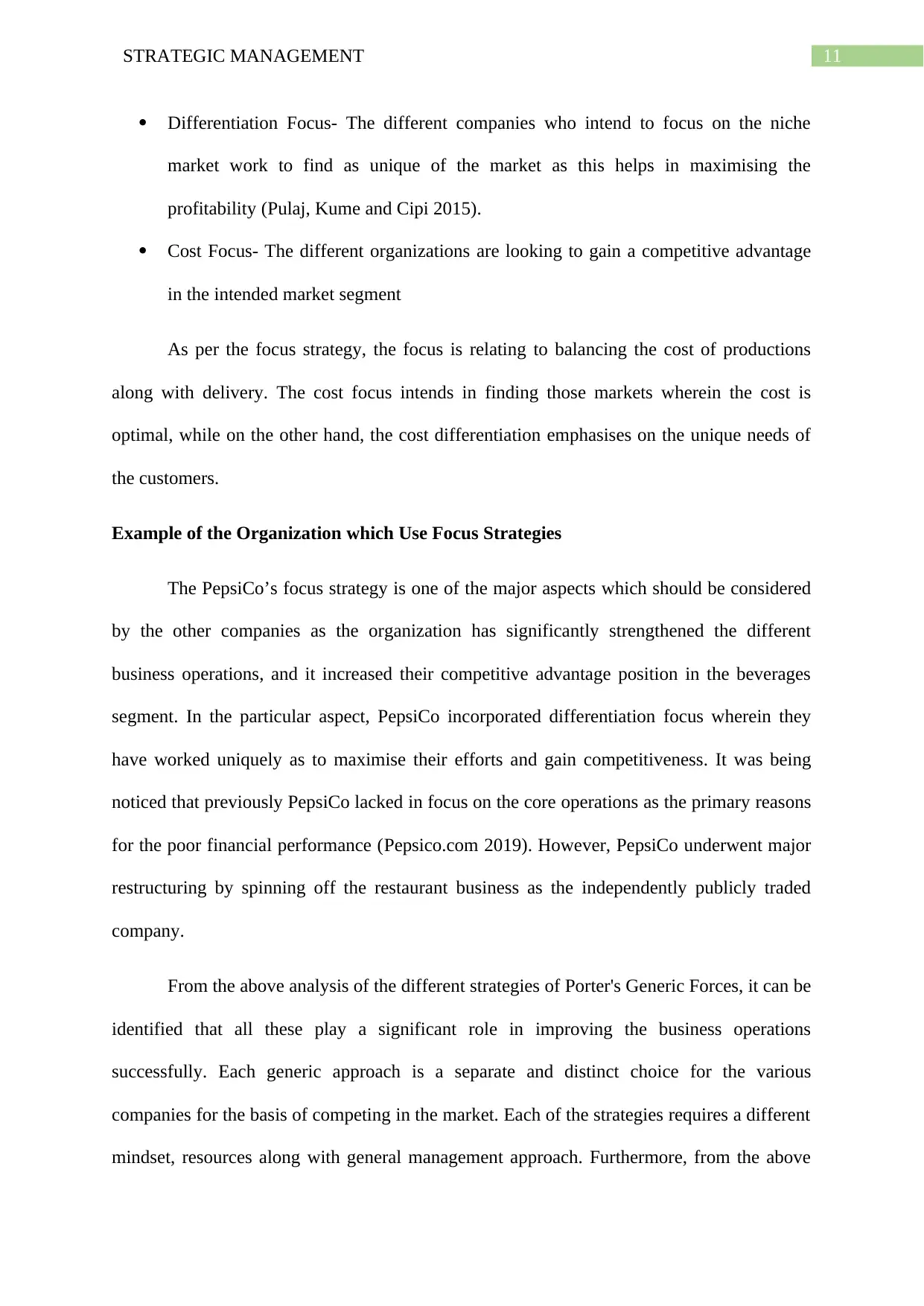
11STRATEGIC MANAGEMENT
Differentiation Focus- The different companies who intend to focus on the niche
market work to find as unique of the market as this helps in maximising the
profitability (Pulaj, Kume and Cipi 2015).
Cost Focus- The different organizations are looking to gain a competitive advantage
in the intended market segment
As per the focus strategy, the focus is relating to balancing the cost of productions
along with delivery. The cost focus intends in finding those markets wherein the cost is
optimal, while on the other hand, the cost differentiation emphasises on the unique needs of
the customers.
Example of the Organization which Use Focus Strategies
The PepsiCo’s focus strategy is one of the major aspects which should be considered
by the other companies as the organization has significantly strengthened the different
business operations, and it increased their competitive advantage position in the beverages
segment. In the particular aspect, PepsiCo incorporated differentiation focus wherein they
have worked uniquely as to maximise their efforts and gain competitiveness. It was being
noticed that previously PepsiCo lacked in focus on the core operations as the primary reasons
for the poor financial performance (Pepsico.com 2019). However, PepsiCo underwent major
restructuring by spinning off the restaurant business as the independently publicly traded
company.
From the above analysis of the different strategies of Porter's Generic Forces, it can be
identified that all these play a significant role in improving the business operations
successfully. Each generic approach is a separate and distinct choice for the various
companies for the basis of competing in the market. Each of the strategies requires a different
mindset, resources along with general management approach. Furthermore, from the above
Differentiation Focus- The different companies who intend to focus on the niche
market work to find as unique of the market as this helps in maximising the
profitability (Pulaj, Kume and Cipi 2015).
Cost Focus- The different organizations are looking to gain a competitive advantage
in the intended market segment
As per the focus strategy, the focus is relating to balancing the cost of productions
along with delivery. The cost focus intends in finding those markets wherein the cost is
optimal, while on the other hand, the cost differentiation emphasises on the unique needs of
the customers.
Example of the Organization which Use Focus Strategies
The PepsiCo’s focus strategy is one of the major aspects which should be considered
by the other companies as the organization has significantly strengthened the different
business operations, and it increased their competitive advantage position in the beverages
segment. In the particular aspect, PepsiCo incorporated differentiation focus wherein they
have worked uniquely as to maximise their efforts and gain competitiveness. It was being
noticed that previously PepsiCo lacked in focus on the core operations as the primary reasons
for the poor financial performance (Pepsico.com 2019). However, PepsiCo underwent major
restructuring by spinning off the restaurant business as the independently publicly traded
company.
From the above analysis of the different strategies of Porter's Generic Forces, it can be
identified that all these play a significant role in improving the business operations
successfully. Each generic approach is a separate and distinct choice for the various
companies for the basis of competing in the market. Each of the strategies requires a different
mindset, resources along with general management approach. Furthermore, from the above
⊘ This is a preview!⊘
Do you want full access?
Subscribe today to unlock all pages.

Trusted by 1+ million students worldwide
1 out of 19
Related Documents
Your All-in-One AI-Powered Toolkit for Academic Success.
+13062052269
info@desklib.com
Available 24*7 on WhatsApp / Email
![[object Object]](/_next/static/media/star-bottom.7253800d.svg)
Unlock your academic potential
Copyright © 2020–2025 A2Z Services. All Rights Reserved. Developed and managed by ZUCOL.





